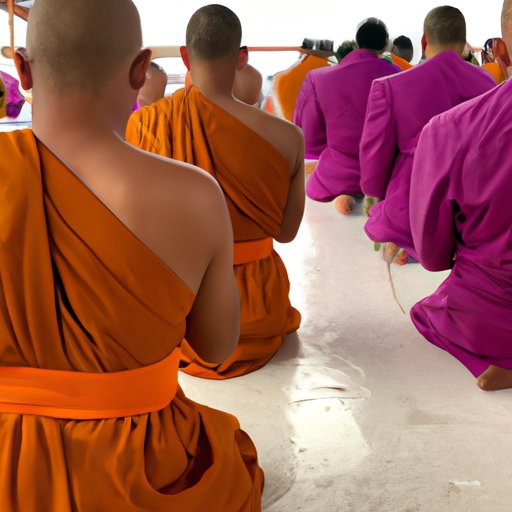Introduction
Buddhism is a religion and philosophy based on the teachings of Siddhartha Gautama who was born in modern-day Nepal around the 5th century BC. He is known as the “Buddha” or “Awakened One” and his teachings have spread throughout the world, becoming one of the most influential spiritual practices of our time. At its core, Buddhism is focused on understanding reality, cultivating wisdom, and ultimately reaching enlightenment.
The core beliefs and teachings of Buddhism include the Four Noble Truths, the Eightfold Path, the Three Jewels (the Buddha, Dharma, and Sangha), the Five Precepts, and the concept of karma. In summary, the Four Noble Truths are that all life is suffering, suffering is caused by desire, ending suffering comes from ending desire, and this can be achieved through following the Eightfold Path. The Eightfold Path consists of eight steps which are Right View, Right Intention, Right Speech, Right Action, Right Livelihood, Right Effort, Right Mindfulness, and Right Concentration.
Buddhist Meditation Practices
Meditation is an important part of Buddhist practice and it has been used for centuries to reach a state of stillness, focus, and inner peace. There are many different types of meditation practices such as mindfulness meditation, loving-kindness meditation, walking meditation, visualization meditation, and mantra meditation. Each type of meditation has different benefits and can be used to cultivate specific qualities such as patience, compassion, and equanimity.
The first step in beginning to practice meditation is to find a comfortable place to sit. It can be helpful to use a cushion or chair to support your back. Once you are settled, close your eyes and take a few deep breaths. Then, begin to focus on your breath as it moves in and out of your body. Allow your mind to settle into the rhythm of your breath without trying to control it. If your mind starts to wander, simply acknowledge the thought and then return to focusing on the breath.

Different Types of Buddhist Traditions
There are three main branches of Buddhism: Theravada, Mahayana, and Vajrayana. Theravada Buddhism is the oldest branch of Buddhism and is considered to be more conservative. It focuses on the teachings of the Pali Canon and emphasizes individual enlightenment. Mahayana Buddhism is more liberal and focuses on the teachings of the Mahayana Sutras. It emphasizes compassion and the concept of bodhisattvas, or enlightened beings who help others achieve enlightenment. Vajrayana Buddhism is the most esoteric form of Buddhism and is practiced mainly in Tibet and Mongolia. It focuses on the tantric teachings of the Vajrayana Sutras and emphasizes the use of ritual and mantra.
The Life of the Buddha and His Noble Eightfold Path
The life of the Buddha is an important part of Buddhist history and tradition. Siddhartha Gautama was born in Lumbini, Nepal and was raised in a wealthy family. At the age of 29 he left home in search of the truth and after six years of searching and meditation, he reached enlightenment and became the Buddha. After his enlightenment, he spent the rest of his life teaching the Dharma (the teachings of the Buddha) and helping people reach enlightenment.
The Buddha’s most famous teaching is the Noble Eightfold Path which consists of eight steps: Right View, Right Intention, Right Speech, Right Action, Right Livelihood, Right Effort, Right Mindfulness, and Right Concentration. This path is the foundation of Buddhist practice and is designed to help practitioners cultivate wisdom, develop ethics, and reach enlightenment.

Participating in a Local Buddhist Community
Participating in a local Buddhist community is a great way to learn about Buddhism and to deepen your practice. There are many ways to find local Buddhist communities such as online directories, local newspapers, and word of mouth. Participating in a local Buddhist community can help you gain insight into Buddhist teachings and provide support and guidance in your practice.
In addition, attending Buddhist retreats or workshops can help you connect with other practitioners and learn more about Buddhism. These retreats often include meditation, lectures, and discussion groups and can provide an opportunity to deepen your understanding of Buddhism and to explore new practices.
Conclusion
Buddhism is a spiritual practice that has been around for centuries and is still relevant today. By understanding the core beliefs and teachings of Buddhism, exploring different meditation practices, understanding different Buddhist traditions, and following the Noble Eightfold Path, anyone can become a Buddhist. Additionally, participating in a local Buddhist community or attending retreats or workshops can provide further insight into Buddhism and help deepen one’s practice.
(Note: Is this article not meeting your expectations? Do you have knowledge or insights to share? Unlock new opportunities and expand your reach by joining our authors team. Click Registration to join us and share your expertise with our readers.)
